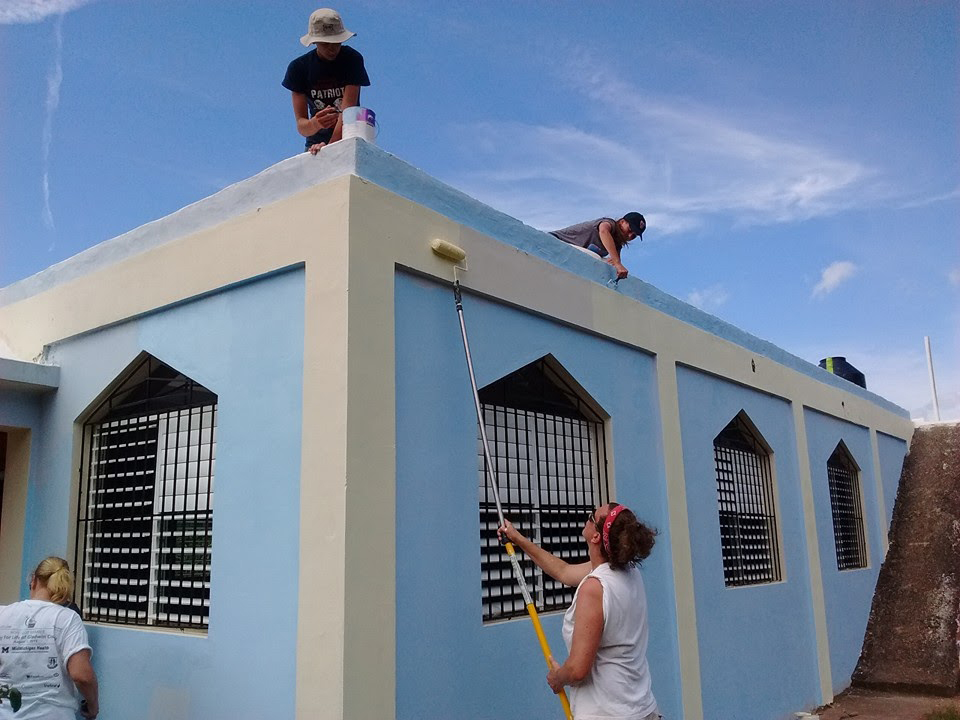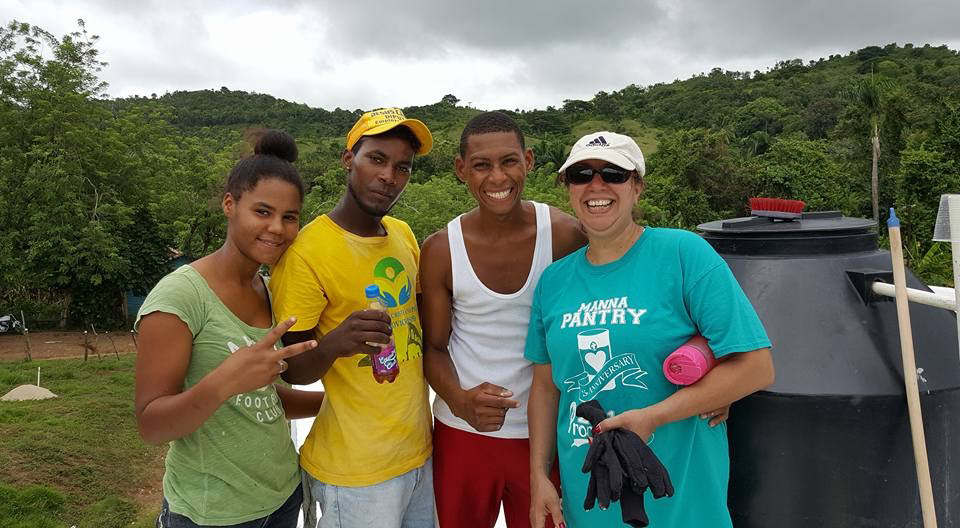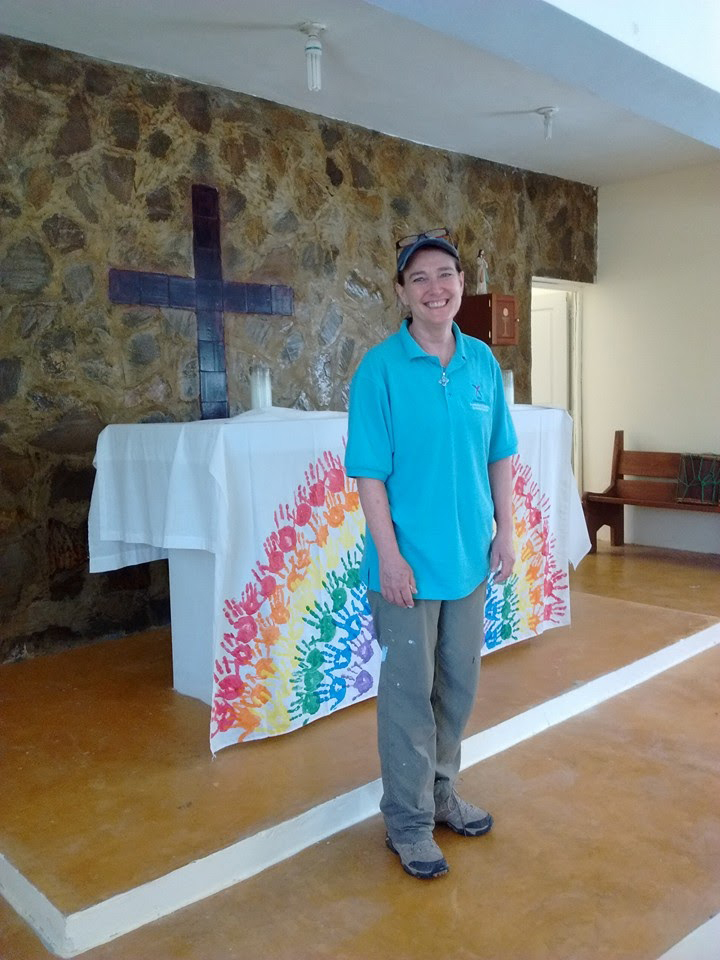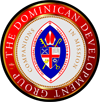“Empowering” – An Eastern Michigan Mission Trip Report
By Alison Reed
Posted November 29, 2016
Alison is a student at Central Michigan University and a member of St. John’s Episcopal Church, Otter Lake, Michigan. This report was first published in The Feast, a publication of the Episcopal Diocese of Eastern Michigan, and is reprinted here with the kind permission of the editor. To see this article as originally published in The Feast, click here.

Painting the exterior of Iglesia Episcopal Divina Gracia in Mozovi. Click this image for an album of photographs from this mission trip.
Empowering.
Last July I had the privilege to go on a one-week mission trip to the Dominican Republic.
It was a wonderful trip, but upon returning I found it difficult to describe its impact to my family and friends. I often told people the material things that I did, like how my group painted a whole church – inside, outside, ceiling, roof, and a water pump building.
I spoke about how getting supplies was next to impossible because the paint store simply didn’t have them. About how we dipped paint rollers into five gallon buckets and quickly slapped the paint on the wall as it dripped.
I shared that I got to practice my Spanish language skills. I was able to work with many native speakers and they were so kind to me, even though I was a bit rusty.
It was my personal spiritual and emotional growth that was harder to put into words. My friend from work told me to try to describe the trip in one word. I thought about it for a bit, and finally settled on ‘empowering’.
It was empowering to work with the Dominican people of Mozovi.

On right: a missioner with three members of the community of Mozovi. This photograph was taken from the rooftop of Iglesia Episcopal Divina Gracia. A water collection cistern is in the right rear of this photograph. Click this image for an album of photographs from this mission trip.
Every day we traveled over an hour over a gravel road from Puerto Plata, where our hotel was located. Picture the worst road in your neighborhood on a bad day, now multiply the amount of potholes by ten and add unpredictable motorcycles weaving in and out. It definitely wasn’t for the faint of heart!
Upon our arrival to the village, a woman named Ana greeted us. She was born with the Zika virus, which causes the head and brain to be smaller than normal. She is considered innocent by the Dominican People, which means she is protected by God. She is not strange or weird like how many special needs adults are treated here in the United States, but rather a person that should be taken care of and treated with kindness.
Ana was our cheerleader for the week. I remember she could run faster than most of my high school track team. I was impressed that she knew many English words. She would yell, “Hello, friends!” when we arrived. When she had a muscle spasm, a side effect of the disease, she would point to where it hurt and say, “Here,” indicating that she wanted you to help alleviate the pain.
In Ana, our group saw that the Zika virus was not the death sentence that it is often portrayed as in the media.
Along with Ana, there were around thirty people from the village working alongside us each day. The men dug a long trench from the new well to the water pump at the church over the course of just one day. The women and young people helped paint and clean. Concrete footings were dug, cement mixed, and then finished under the foundation of the small original church – which is to be used a patio for Bible studies and as a place for people to sit while children play in the soon-to-be daycare at the church.
I thought I was going to be helping the “poor people” of the Dominican Republic, but instead I was met with one of the richest cultures. They embody the hospitality lessons that the Bible teaches us. I often heard these lessons in my church, but they never really impacted me until my trip.
My group arrived only hours after the local priest returned from a spontaneous three day meeting with the Dominican Bishop. Each priest in the Episcopal Diocese of the Dominican Republic has three churches they travel between because they have such a shortage of clergy. All the money for projects has to be approved by the Bishop as to avoid the corruption that plagues the area.
Because of logistics there was a lot of down time when we first arrived and throughout the week when we ran out of materials. At these times we were invited to sit with the Dominican people and simply be together. They would bring platters of fruit for us to eat. My favorite were limes that were the size of oranges. Sweet, with just a touch of bitterness at the end.
They took us to the local river so that we could dip in our tired feet. These people – so impoverished that sometimes they could not afford shoes –hosted us with open arms.
They regularly run out of water, only have electricity for a few hours a day, and live in what we in the developed world would call shacks. They are monetarily poor, but they are so filled with God’s love and embody his words in ways that makes our culture seem like the poor one.

The Rev. Deacon Beth Drew in front of the altar of Iglesia Episcopal Divina Gracia. Click this image for an album of photographs from this mission trip.
David Morrow, one of the three founders of the group came to meet with La Reverenda Ercilia, the local Dominican priest, and the Rev. Deacon Beth Drew, who leads the trips from Michigan. I thought it was awesome to meet and speak with one of the founders of a huge non-profit. I expected him to be in an air-conditioned office, not personally checking in with us.
I also got to visit two other churches – San Símon and Santa María – to see the schools and medical clinics that are being created. I liked that the Dominican Development Group was working to work with the Dominican people rather than to “save” them. They look for communities with no churches, no schools, no doctors, and then, working with area leaders, provide opportunities for sustainable projects. They meet regularly to ensure the relationship is working toward their goals rather than what we might think they need.
One of the many sustainable projects is a new college partnership working with students from Florida and Caribbean Cruise Lines to help teach Dominican people how to make soap. I actually brought a bar home with me. The students are coming over to teach the soap making process and to help set up the business. They are going to help figure out costs, prices, and other logistics. Caribbean Cruise Lines is providing the transportation for the students in return for the ability to advertise the program. The Dominican people will be incorporating several different scents using fruits from around the island and then will sell them in local shops and at the churches to benefit continuing parish ministry.
In addition to the impact of the Dominican Republic and its people, our Michigan mission group was amazing. There were eleven of us. It was such a diverse group and yet each person inspired me with their faith.
There were three teenagers, Amy, Brittany, and Cooper, who were young but so devoted. They were typical teenagers who joked around, played cards, and openly talked about God. In my church experience, I had not yet had the privilege of working alongside many teens in the Episcopal Church.
Two moms, who were their youth leaders, came on the trip as well. These women discussed how to keep improving their programs with absolute rigor. I remember they were impressed by our Vacation Bible School at St. John’s in Otter Lake, because they had never heard of local churches collaborating to put on such a “large” program.
At our hotel there was another Episcopal group from South Carolina, almost all teenagers with their youth ministers and parents. I got to see the teachers trade program ideas, and the kids talk about their churches, about sports and school, and discuss the expectations they had before the trip. One said, “I thought language was going to be the biggest barrier, but, you know, ignorance was harder to deal with.” – pretty impressive for a 15-year-old kid experiencing a whole new culture for the first time.
I was also empowered by my friend Phyllis. She is seventy years old, has fought and beat breast cancer, and went on this trip and worked just as hard as the teenagers. The native people called her Mama, to show her respect.

On left: Alison Reed, the author of this article. Click this image for an album of photographs from this mission trip.
She heard about the trip in the newsletter from the Diocese of Western Michigan, looked at her calendar, and said, “Well, I’m free”. So for those of you thinking that you are too old to be called upon for a spiritual adventure, Phyllis scoffs at you.
Her faith is unyielding. Her positivity kept spirits high all week. And the woman was better than Mr. Clean when it came time to pick up our messes.
My trip was empowering because it demonstrates how people can be connected by faith. Across differences in language and culture, across the Dominican people and the folks from the United States, we worked together to create a better world.
We were eleven strangers who showed up, speaking a different language, saying we were there to paint. They sat with us. Talked with us. Took us into their space and into their hearts.
We experienced radical welcome. They embodied it as they treated us like family. Would we do the same?

